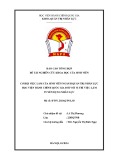
A selenium-containing single-chain abzyme with potent
antioxidant activity
Delin You
1
, Xiaojun Ren
1,2
, Yan Xue
1
, Guimin Luo
1
, Tongshu Yang
1
and Jiacong Shen
2
1
Key Laboratory of Molecular Enzymology and Engineering of Ministry of Education, Jilin University, Changchun, P. R. China;
2
Key Laboratory for Supramolecular Structure and Materials of Ministry of Education, Jilin University, Changchun, P. R. China
Reactive oxygen species (ROS) are products of normal
metabolic activities and are thought to be the cause of many
diseases. A selenium-containing single-chain abzyme 2F3
(Se-2F3-scFv) that imitates glutathione peroxidase has been
produced which has the capacity to remove ROS. To
evaluate the antioxidant ability of Se-2F3-scFv, we con-
structed a ferrous sulfate/ascorbate (Vc/Fe
2+
)-induced mito-
chondrial damage model system and investigated the
capacity of Se-2F3-scFv to protect mitochondria from oxi-
dative damage. Se-2F3-scFv markedly decreased mito-
chondrial swelling, inhibited lipid peroxidation, and
maintained the activity of cytochrome coxidase, in com-
parison with Ebselen, a well-studied glutathione peroxidase
mimic, indicating that Se-2F3-scFv has potential for treating
diseases mediated by ROS.
Keywords: antioxidant activity; glutathione peroxidase;
mitochondria; scFv; selenium.
Reactive oxygen species (ROS) include free radicals such as
superoxide anion (O
2–•
) and hydroxyl radical (
•
OH), as well
as nonradical intermediates such as hydrogen peroxide
(H
2
O
2
), hydroperoxide (ROOH), nitric oxide (NO) and
singlet oxygen (
1
O
2
) [1,2]. All these ROS are produced from
molecular oxygen by mitochondrial electron carriers and
from enzymes during normal metabolism of oxidative
phosphorylation of aerobic mammalian cells. In addition,
ROS are produced on irradiation, both ionizing and UV
irradiation.
To protect themselves from oxidative injury, aerobic
cells have evolved an enzymatic and nonenzymatic defense
system. The enzymatic antioxidant system is mainly
composed of glutathione peroxidase (GPX), catalase,
superoxide dismutase and thioredoxin peroxidase. The non-
enzymatic antioxidant system includes vitamin E, ascorbate,
glutathione (GSH) and uric acid. However, if the ROS
loading reaches a critical concentration, overwhelming the
antioxidative defense, oxidative damage to all cellular
components, such as DNA, proteins and lipids, eventually
occurs, resulting in ROS-mediated diseases [3–5]. Exam-
ples of such diseases are ischemia-reperfusion injury,
inflammation, age-related diseases, neuronal apoptosis,
cancer and cataract.
The individual antioxidant enzymes are located in
specific subcellular sites and reveal distinct substrate
specificity [6]. Superoxide dismutase is a metalloenzyme
that catalyzes the reduction of O
2–•
to H
2
O
2
.H
2
O
2
produced by the reduction of O
2–•
is subsequently
detoxified by catalase present in peroxisomes or by the
selenoenzyme GPX located in the cytosol and mitochon-
dria. GPX, the most important selenium-containing
peroxidase, catalyzes the reduction of a variety of
hydroperoxides (ROOH and H
2
O
2
) by GSH, thereby
protecting mammalian cells against oxidative damage. At
least five GPX isoenzymes have been identified in
mammals. Although their expression is ubiquitous, the
levels of each isoform vary depending on the tissue type.
The classical cellular GPX (GPX1 or cGPX), found in the
cytosol and mitochondria, reduces fatty acid hydroper-
oxides and H
2
O
2
[7–9]. Phospholipid hydroperoxide GPX
(GPX4 or PHGPX), found in most tissues and located in
both the cytosol and the membrane fraction, can directly
reduce the phospholipid hydroperoxides, fatty acid hydro-
peroxides, and cholesterol hydroperoxides that are
produced in peroxidized membranes and oxidized lipo-
proteins [10–12]. Cytosolic GPX2 (or giGPX) [13,14] and
extracellular GPX 3 (pGPX) [15,16] are weakly detected
in most tissues except gastrointestinal tract and kidney,
respectively. Recently, a new member, GPX5, expressed
specifically in mouse epididymis, is interestingly selenium-
independent [17]. The mechanism by which cGPX cata-
lyzes the reduction of hydroperoxide has been extensively
investigated.
Because production of selenium-containing peroxidase
is extremely difficult by traditional genetic engineering,
attempts have been made to generate compounds that
imitate the enzymatic action of GPX. The strategies used
to generate GPX-like catalysts include chemical synthesis
of a model system and mutation of naturally occurring
enzyme by chemical or protein engineering [18–20]. Three
different strategies have been tested for chemically
synthesizing a GPX mimic: one in which the selenium
atom binds directly to a heteroatom such as nitrogen
Correspondence to G. Luo, Key Laboratory of Molecular
Enzymology and Engineering of Ministry of Education,
Jilin University, Changchun, P. R. China.
Fax: + 86 431 8923907, Tel.: + 86 431 8498974,
E-mail: gmluo@mail.jlu.edu.cn
Abbreviations: ROS, reactive oxygen species; GSH, glutathione; GPX,
glutathione peroxidase; TBA, thiobarbituric acid; CCO, cytochrome c
oxidase; TBARS, thiobarbituric acid reactive substances.
(Received 20 April 2003, revised 6 July 2003,
accepted 22 August 2003)
Eur. J. Biochem. 270, 4326–4331 (2003) FEBS 2003 doi:10.1046/j.1432-1033.2003.03825.x

and generates the well-known GPX mimic, 2-phenyl-1,
2-benziososelenazol-3(2H)-one (Ebselen); a second in
which the selenium atom is not directly bound to the
heteroatom (N or O), but instead is located in close
proximity to it; and the third in which cyclodextrin is
used as an enzyme model and the selenium is not directly
bound or located in close proximity to the heteroatom.
Engineering of naturally occurring enzyme by chemical
or genetic means has resulted in the semisynthetic
enzyme selenosubtilisin and a mutant version of glycer-
aldehyde-3-phosphate dehydrogenase. Ebselen is an inter-
esting GPX mimic and has been extensively investigated
in studies of structure–function correlation and ability to
scavenge ROS in clinical trials [21–24], but it has some
drawbacks, such as low GPX activity and water
insolubility. In previous work, we produced a series of
selenium-containing catalytic antibodies [25–27]. One of
them, the selenium-containing abzyme 2F3 (Se-2F3),
exhibited high catalytic activity, 4.3 times that of GPX
from rabbit liver [27]. To generate a pharmacologically
useful protein and study the cause of the highly catalytic
efficiency of Se-2F3, we sequenced, cloned and expressed
the variable region genes of 2F3 as a single-chain
antibody (2F3-scFv), and then incorporated selenium
into the 2F3-scFv by chemical mutation, resulting in the
selenium-containing 2F3-scFv (Se-2F3-scFv). Se-2F3-scFv
catalyzes the reduction of H
2
O
2
at rates approaching that
of native GPX from rabbit liver [28,29]. The optimal pH
and temperature for the Se-2F3-scFv-catalyzed reduction
of H
2
O
2
were determined to be 8.27 and 47.2 C,
respectively, similar to those of native GPX [29]. In this
study, we constructed a biological model of ROS-induced
mitochondrial damage to study the ability of Se-2F3-
scFv to protect mitochondria from oxidative damage. We
found it to be a potent antioxidant.
Materials and methods
Materials
GSH was obtained from Aldrich. Ebselen, glutathione
reductase (type III baker’s yeast) and NADPH (tetrasodium
salt) were obtained from Sigma. Thiobarbituric acid (TBA)
was obtained from Shanghai Second Reagent Plant,
Shanghai, China. Cytochrome cwas obtained from Tianjin
Biochemical Plant (Tianjin, China). Hepes was from Fluka.
All other chemicals were of analytical grade.
Generation of Se-2F3-scFv
The expression vector pTMFscFv containing target genes
was constructed as described previously and transformed
into bacterial cells BL21 (coden plus). After isopropyl thio-
b-
D
-galactoside induction, the expressed amount of 2F3-
scFv proteins was 25–30% of total bacterial proteins. The
2F3-scFv proteins were purified and refolded into the active
form. Incorporation of selenium into 2F3-scFv protein by
chemical mutation resulted in the selenoenzyme Se-2F3-
scFv. The GPX activity of Se-2F3-scFv was determined by
the coupled coenzyme system. One unit of activity is defined
as the amount of compound that utilizes lmol NADPHÆ
min
)1
at 37 C [28].
Preparation of mitochondria
Bovine heart mitochondria were isolated from fresh bovine
heart as described previously [30]. Mitochondria were
suspended in 0.25
M
sucrose/10 m
M
EDTA/25 m
M
Hepes/
NaOH buffer, pH 7.4, and maintained at 0 C. The
concentration of the mitochondrial proteins was determined
by the method of Bradford [31] with BSA as standard.
Ferrous sulfate/ascorbate (Fe
2+
/Vc)-induced mitochondrial
damage
Mitochondria (2 mg proteinÆmL
)1
) suspended in peroxida-
tion medium(150 m
M
KCl, 10 m
M
EDTA, 1 m
M
GSH,
25 m
M
Hepes/NaOH, pH 7.4) were subjected, in the
absence and presence of Se-2F3-scFv, to oxidative stress
generated by 50 l
M
Fe
2+
plus 2 m
M
ascorbate at 37 C.
Damage experiments were carried out without Se-2F3-scFv
protein and known as the damage group; experiments
carried out without Se-2F3-scFv, ascorbate, and Fe
2+
were
known as the control group [32].
Measurement of lipid peroxidation
LipidperoxidationintheVc/Fe
2+
-induced mitochondrial
damage system was analyzed by the TBA assay. In this
assay, TBA reacts with malonaldehyde and/or other
carbonyl by-products of free-radical-mediated lipid per-
oxidation to give 2 : 1 (mol/mol) colored conjugates [33].
Before and during incubation with the different concentra-
tions of Se-scFv-2F3, a 1.0 mL aliquot was taken and
vortex-mixed with 1 mL 75% (w/v) trichloroacetic acid and
1 mL 0.5% (w/v) TBA in water. The assay mixtures were
heated for 40 min at 80 C. After cooling and centrifuga-
tion, A
532
of the supernatants was recorded. These readings
(corrected for blanks) were converted into thiobarbituric
acid reactive substance (TBARS) values, using an absorp-
tion coefficient obtained for authentic malonaldehyde,
1.56 ·10
5
M
)1
Æcm
)1
.
Assay of mitochondrial swelling
Swelling of mitochondria was assayed as described by
Hunter et al. [34]. Changes in light scattering are correlated
with mitochondrial swelling. Mitochondrial swelling was
measured as the decrease in turbidity of the reaction mixture
at 520 nm. The decrease in absorbance indicates an increase
in mitochondrial swelling and a decrease in mitochondrial
integrity.
Assay of cytochrome
c
oxidase (CCO) activity
An aliquot of incubation mixture from the Damage group
or Control group was taken at different time intervals and
centrifuged (10 000 g,4C, 2 min).The pellet was washed
with 10 m
M
potassium phosphate buffer, pH 7.4, contain-
ing 125 m
M
KCl, 1 m
M
MgCl
2
,and5m
M
glutamate. Then
it was suspended in a small amount of 100 m
M
potassium
phosphate buffer, pH 7.0, and an aliquot was taken for
assay of CCO activity [35]. The CCO activity was measured
in 2 mL of the reaction system, in which the cytochrome c
concentration was 15 l
M
. The absorbance was decreased
FEBS 2003 Se-containing abzyme with potent antioxidant activity (Eur. J. Biochem. 270) 4327

with oxidation of cytochrome cin the sample cell, into
which 5 lL10m
M
K
3
Fe(CN)
6
was added to oxidize
cytochrome cthoroughly when the reaction was completed.
The absorbance intensity at this time was recorded as A
1
.
The plot of ln(A
t
)A
1
) vs. time was made. The absolute
value of the line slope, K
app
, was the apparent rate constant
of cytochrome coxidationandwasusedtoexpressCCO
activity.
Results
The GPX activity of Se-2F3-scFv
We successfully cloned the variable regions of antibody 2F3
genes and expressed them as inclusion body proteins [28].
After refolding of inactive 2F3-scFv protein, the catalytic
residue Sec was incorporated into the binding site by
chemical modification to produce the selenium-containing
abzyme Se-2F3-scFv. Se-2F3-scFv catalyzed the reduction
of H
2
O
2
by GSH as listed in Table 1. The activity was
2840 ± 113.6 UÆlmol
)1
,whichis49.1%ofthatofrabbit
liver GPX. This is a relatively high figure, although it is only
11.7% of that of the intact monoclonal catalytic antibody
Se-2F3. This activity is 2870 times that of the well-studied
GPX mimic Ebselen (PZ51). These results are similar to
previous reports [28,29].
Inhibition of lipid peroxidation by Se-2F3-scFv
The polyunsaturated fatty acid in mitochondrial membrane
is readily attacked by ROS, especially
•
OH produced by the
Fenton reaction, producing TBARS. TBARS therefore was
used to measure the extent of lipid peroxidation. TBA reacts
with malonaldehyde and/or other carbonyl by-products of
free-radical-mediated lipid peroxidation to give 2 : 1 (mol/
mol) colored conjugates [33], which have an A
532
value.
Bovine heart mitochondria exposed to (Fe
2+
plus
ascorbate)-induced oxidative stress are peroxidized in a
time-dependent manner as indicated by the formation of
TBARS from membrane lipids. Over 50 min, the amount of
TBARS accumulated in the damage group was between
2.40 ± 0.02 and 3.14 ± 0.03 nmol per mg protein and for
the control group it was between 2.03 ± 0.02 and 2.32 ±
0.02 nmol per mg protein. The increased TBARS in the
damage group was 2.2-fold higher than that in the control
group.
Figure 1 shows that Se-2F3-scFv effectively protects
membrane lipids from Fe
2+
/Vc-induced oxidative damage.
The inhibition of lipid peroxidation by Se-2F3-scFv proteins
was strongly dependent on the concentration of Se-2F3-
scFv. The amount of TBARS produced decreased with an
increase in Se-2F3-scFv concentration. When the concen-
tration of Se-2F3-scFv protein was 8.35 l
M
, the TBARS
content was 56 ± 1.7% of the damage group, indicating
that TBARS production was inhibited by 44%. The
antioxidant activity of Ebselen was also determined in this
experiment. When the concentration of Ebselen was
8.00 l
M
, the TBARS content was only 89.4 ± 2% of the
damage group, indicating that TBARS production was
inhibited by 10.6%. Therefore, Se-2F3-scFv was more
protective than Ebselen. This is in agreement with their
GPX activities.
Effect of Se-2F3-scFv on swelling of the damaged
mitochondria
Swelling and shrinking of mitochondria is a normal
physiological phenomenon during respiration. However,
abnormal swelling will disrupt the mitochondrial membrane
resulting in cell death. Mitochondrial swelling therefore
characterizes its integrity. It can be correlated with changes
in light scattering. A decrease in A
520
reflects an increase in
mitochondrial swelling and a decrease in mitochondrial
integrity.
The A
520
for the control group remained basically
constant, whereas that for the damage group decreased
considerably with time, indicating that the Fe
2+
/Vc-induced
damage resulted in extensive mitochondrial swelling. The
reason for the swelling is that H
2
O
2
produced by Fe
2+
/Vc is
converted into
•
OH by the Fenton reaction, which initiates
Table 1. GPX activity of Se-2F3-scFv, Se-2F3, Ebselen and native GPX
from rabbit liver. GPX activity was assayed by the coupled coenzyme
system. Reactions were carried out in 50 m
M
potassium phosphate
buffer, pH 7.0, at 37 C, 1 m
M
GSH, 0.5 m
M
H
2
O
2
.Dataare
means ± SD (n¼three separate experiments).
Species
GPX activity
UÆlmol
)1
UÆmg
)1
Se-2F3-scFv 2840.0 ± 113.6 94.7 ± 3.8
Se-2F3 24 300 ± 729 162.0 ± 4.9
Ebselen 0.99 3.61
Native GPX 5780 85.7
Fig. 1. Effect of Se-2F3-scFv on the production of TBARS. Bovine
heart mitochondria were incubated for 50 min with ascorbate (2 m
M
)/
Fe
2+
(50 l
M
) in the presence of various concentrations of Se-2F3-scFv
at 37 C. The extent of lipid peroxidation was measured as accumu-
lation of TBARS as described in Materials and methods. Data are
expressed as mean ± SD for five independent preparations.
4328 D. You et al.(Eur. J. Biochem. 270)FEBS 2003



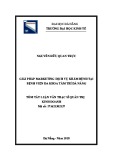
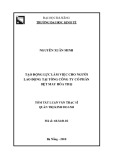
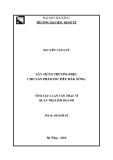
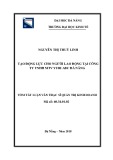


![Hình ảnh học bệnh não mạch máu nhỏ: Báo cáo [Năm]](https://cdn.tailieu.vn/images/document/thumbnail/2024/20240705/sanhobien01/135x160/1985290001.jpg)
